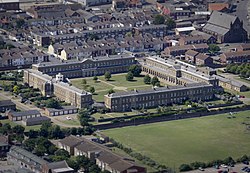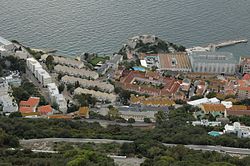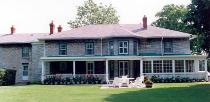Royal Naval Hospital
A Royal Naval Hospital (RNH) was a
For most of their history the naval hospitals at home were listed in the
The list below includes significant Royal Naval Hospitals established in the 18th-20th centuries; in addition numerous smaller facilities (often classed as Sick Quarters) were set up, where and when needed (especially in times of war).[10]
In 1996 the UK's last remaining Royal Naval Hospital was redesignated as a
Historical overview
Individual

By the turn of the century, permanent hospital provision was being contemplated for overseas bases. An early experiment was the prefabricated hospital set up in Jamaica by Admiral John Benbow in 1701, for which the Sick and Hurt Commissioners provided a salaried surgeon and other staff. This was followed by the provision of staffed hospitals in Lisbon in 1705 and Minorca in 1711.[13] At home, however, the navy continued to rely on contract hospitals, such as the Fortune Hospital in Gosport (opened under contract in 1713), and similar establishments in Deal and Rochester. When additional capacity was required inns were often hired and converted into sick quarters, or beds set aside in the large London hospitals.[14]

During the War of Jenkins' Ear, however, the system was overwhelmed by large numbers of returning sick and injured (over 15,000 in the 13 months from July 1739 to August 1740).[13] The following year a proposal was put forward to the Admiralty for the establishment of three hospitals, to be owned, built and run by the Royal Navy, in the vicinity of the principal home ports. In 1744, with France having declared war on Britain, the decision was finally taken to establish Royal Naval Hospitals on a permanent footing in Gosport (Royal Hospital Haslar) and Stonehouse (Royal Hospital Plymouth); however a proposed third hospital (at Queenborough) was not then built, as Chatham by that time had ceased to function as a front-line base.[13]

In the decades that followed more Royal Naval Hospitals were established, both at home and abroad. During the Napoleonic Wars there were five naval hospitals operating in England: in addition to Haslar and Plymouth, hospitals were established at Paignton (for the Channel Fleet), Great Yarmouth (for the North Sea and Baltic Fleets) and Deal.[15] At the same time hospital ships were provided at Woolwich, Sheerness and Chatham. Gibraltar served the needs of the fleet in the Mediterranean at this time (Minorca having been ceded to Spain); while, further afield, Royal Naval Hospitals had been established in various locations including India, North America and the Caribbean.
At the start of the First World War, the three principal naval hospitals in the UK were Haslar, Plymouth and Chatham (serving the needs of the three home Commands: Portsmouth, Plymouth and The Nore); Yarmouth was also retained, as a psychiatric hospital.[10] Smaller hospitals at Portland, South Queensferry, Pembroke Dock and Haulbowline served nearby naval dockyards; while Scotland, where the Grand Fleet was based, saw two hospitals commandeered for use by the Admiralty: Leith Public Health Hospital became Royal Hospital Granton in 1917, and the Stirling District Asylum briefly became RNH Larbert in 1918.[16] The main overseas Royal Naval Hospitals at this time were on Malta, Gibraltar, Bermuda, the Cape of Good Hope and Hong Kong.[10]
In the 1920s a degree of rationalisation took place: Chatham Military Hospital and Gibraltar's Royal Naval Hospital were both closed (on the understanding that Chatham's army personnel could be treated at the naval hospital there, and Gibraltar's naval personnel at the military hospital there).[17] Not long afterwards military hospitals near Portsmouth and Plymouth were also closed on the understanding that soldiers could be treated at the nearby naval hospitals.

During the Second World War there was concern about the vulnerability of the older hospitals (which were prominent buildings close to naval dockyards) to aerial bombardment. Auxiliary hospitals were opened in safer locations around Britain (usually in requisitioned civilian hospitals, but schools, hotels and country houses were also used).[18] Malta was also seen as vulnerable to attack, so an auxiliary hospital was opened in a wing of Victoria College, Alexandria to serve the needs of the Mediterranean Fleet.[18] Further east, RNH Hong Kong was destroyed by bombing in 1941, leaving auxiliary hospitals in Ceylon, South Africa and Oceania to take up the strain.
A number of naval hospitals were closed (or transferred to civilian operation) in the late 1950s and early 1960s. In the 1990s, the total number of remaining Naval, Military and RAF Hospitals in the UK was progressively cut from seven, to three, to one: the naval hospital at Haslar (thenceforward to be run as a tri-service institution);[19] by the end of the decade, its closure too had been announced.
Oversight and command
In the early decades of their existence, the hospitals at Haslar and Plymouth were each overseen by a 'Physician and Council' (the Physician being the senior medical officer on the staff).[20]
In 1795, following an enquiry into the situation at Haslar, it was judged that the two naval hospitals were suffering from 'a want of proper discipline and subordination'. To counter this, the decision was taken to remove administrative oversight from the medical staff and to vest it in a trio or quartet of serving naval officers, who were given accommodation on site: the Governor (usually a
In 1869 an enquiry took place into the condition and organisation of the naval hospitals; the report was presented to Parliament and the following year saw the Captains-superintendent and Lieutenants of naval hospitals abolished. Afterwards, oversight reverted to the Medical Officer in Charge.[22]
Throughout this period, the overseas hospitals (which had a far smaller staff establishment) were almost invariably overseen by the senior medical officer on station.[23]
The Royal Naval Hospitals included:
United Kingdom


- Royal Naval Hospital Haslar (Gosport); opened 1753 as the Royal Hospital Haslar, designated as the tri-Service core military hospital in 1996. The military withdrew in 2007 and it closed in 2009; undergoing conversion into a residential retirement village.
- Royal Naval Hospital, Plymouth (Stonehouse); opened 1760, closed 1995, converted into flats.
- Royal Naval Hospital Great Yarmouth; opened 1793 to serve ships anchoring in Yarmouth Roads, relocated 1815, specialised in psychiatric cases from 1863; transferred to NHS 1958, closed and converted to residential flats 1993.
- Royal Naval Hospital Deal, Kent; opened 1800 to serve naval vessels anchored in The Downs, converted into Royal Marine Barracks in 1863 and occupied by the Royal Naval (later Royal Marine) School of Music from 1930 to 1996.
- Royal Naval Hospital Paignton; opened 1800 to serve the naval anchorage of Tor Bay, closed 1816.
- Melville Hospital, Chatham: opened as a Royal Marine Infirmary in 1828,[24] became a Royal Naval Hospital in 1885;[15] replaced by RNH Chatham in 1905 (buildings converted into RMbarracks extension, demolished c.1960).
- Royal Naval Hospital Chatham (Gillingham, Kent); opened 1905 (replacing the Melville Hospital); transferred to NHS in 1961, now Medway Maritime Hospital (NHS).
- Royal Naval Hospital, Irish Governmentin 1923.
- Royal Naval Hospital, Portland, Dorset; opened 1901, closed 1957.
- Royal Naval Hospital, Pembroke Dock; opened 1902, expanded by the RAF during World War II, transferred to the NHS in 1961[26] (now South Pembrokeshire Hospital).
- Butlaw Naval Hospital (Royal Naval Sick Quarters, South Queensferry); small hospital opened c.1910 to serve the new Royal Dockyard at Rosyth, expanded during World War I, closed 1928.
- Royal Naval Hospital Port Edgar opened in 1939,[27] remained active throughout World War II;[28] closed 1950.[29]
- Royal Naval Hospital Granton; opened January 1917 to serve vessels based in Scottish waters,[30] closed 1920.
Overseas
Hospitals were established close to several of the overseas Naval Yards, including:



- Royal Naval Hospital, Port Mahon, Menorca (1711), built on the Illa del Reiin the harbour, ceded to Spain 1782 but remained in use thereafter until c.1960.
- Royal Naval Hospital, Port Royal, Jamaica (1743) rebuilt 1755 and 1818, closed 1905.
- Old Naval Hospital, Gibraltar (1741) closed in 1922 (and subsequently served as naval married quarters); buildings survive having been converted into housing.
- Royal Naval Hospital Gibraltar (1963) (established as a Military Hospital in 1903), closed in 2008.
- Royal Naval Hospital, Madras (1745), closed in 1790, new hospital opened 1808, closed 1831 (became a gun-carriage factory).[31]
- Royal Naval Hospital, English Harbour, Antigua (1763) destroyed by a hurricane and rebuilt 1783, closed 1825.
- Royal Naval Hospital, Halifax, Nova Scotia, Canada (1782) rebuilt 1863, closed 1911 (taken over by the Royal Naval College of Canada).
- Royal Naval Hospital, aerial ropeway provided access from 1904 to 1934), closed 1957. Buildings currently used by South African Navy Band.[32]
- Royal Naval Hospital, Bermuda (1818), closed in 1957, demolished in 1972 (except the
- Royal Naval Hospital, Georgetown, Ascension Island (1831) remains in use as a civilian hospital.
- Royal Naval Hospital, Bighi, Malta(1832), closed 1970.
- Royal Naval Hospital, Mtarfa, Malta (1970) (established as a Military Hospital in 1912), closed 1978.
- Royal Naval Hospital, Esquimalt, British Columbia, Canada (1855) rebuilt 1887–91, closed 1922.
- Royal Naval Hospital, Trincomalee Garrison, Ceylon (present-day Sri Lanka) (1871).
- Royal Naval Hospital, Wanchai, Hong Kong (1873), destroyed 1941 (site became Ruttonjee Hospital).
- New naval hospital (War Memorial Hospital) Hong Kong (1949), closed 1959 (site taken over by the nearby Matilda Hospital).
- New naval hospital (War Memorial Hospital) Hong Kong (1949), closed 1959 (site taken over by the nearby
- Royal Naval Hospital, Yokohama, Japan (1876), (the Hong Kong hospital establishment routinely moved to Yokohama each summer);[13] destroyed in the Great Earthquake of 1923.

Other naval hospitals were established in other overseas locations, usually in the vicinity of other small naval establishments (e.g. coaling or supply yards) including on
During the

Royal Naval Sick Quarters (defined in the 20th century as being 'junior to a general hospital, but senior to a
During the Second World War numerous Sick Quarters were established ('sometimes almost overnight') to meet the needs of the moment: by 1945 there were over a hundred such facilities operating at home and several dozen abroad.[10]
Royal Marine Infirmaries

The Royal Hospital at Greenwich
Greenwich Hospital, which predated all the above institutions, was established on somewhat different grounds, as it cared for retired seamen rather than those on active service. Also called the Royal Hospital for Seamen in Greenwich, it was a home for Greenwich pensioners, established in 1692, and although closed at Greenwich in 1869 still exists as a charity. Its buildings housed the Royal Naval College, Greenwich between 1873 and 1998 and are now open to the public as the Old Royal Naval College.
References
- ^ "Sick And Hurt Board, In-Letters And Orders - National Maritime Museum". collections.rmg.co.uk. Royal Museums Greenwich. Retrieved 23 January 2017.
- ^ Wickenden, Jane (6 September 2013). "The Royal Naval Medical Service from the earliest times to 1918 - British Naval History, Historic Collections Librarian, Institute of Naval Medicine, Alverstoke, Gosport". Global Maritime History. British Naval History, 6 Sep, 2013. Retrieved 29 November 2020.
- ^ The Navy List for January 1820. London: John Murray. 1820. p. 122.
- ^ The Navy List corrected to the 20th December 1854. London: John Murray. 1855. p. 195.
- ^ The Royal Navy List. London: Witherby & Co. July 1880. p. 231.
- ^ The Monthly Naval List. London: His Majesty' Stationery Office. March 1913. pp. 554–556. Retrieved 11 April 2024.
- ^ The Navy List, July 1945 (Volume 3). London: Lords Commissioners of the Admiralty. 1945. pp. 2313–2334. Retrieved 11 April 2024.
- ^ e.g. "Promotions and Appointments". The Naval Chronicle. III: 516. May–June 1800.
- ^ Burney, William (1815). A New Universal Dictionary of the Marine. London: J. Murray. p. 348.
- ^ a b c d e Coulter, Surgeon Commander J.L.S. (1954). "Medical Establishments in the United Kingdom". The Royal Naval Medical Service, Volume I: Administration. London: HMSO. p. 310.
- ^ "Haslar Hospital closure march". BBC News. 29 March 2007. Retrieved 7 April 2024.
- ^ "British Naval History article".
- ^ a b c d e f Coad, Jonathan (2013). Support for the Fleet: Architecture and engineering of the Royal Navy's bases, 1700-1914. Swindon: English Heritage. p. 24.
- ^ Coad, Jonathan G. (1989). The Royal Dockyards1690-1850. Aldershot, Hants.: Scolar Press. pp. 295–297.
- ^ a b "The Royal Naval Hospital, Chatham". The Navy and Army Illustrated. VII (93): 170–171. 12 November 1898.
- ^ "Queensferry History". War in the Forth. Retrieved 16 April 2024.
- ^ Hansard, House of Commons, vol.214, c.18, 28 February 1928: Fighting Forces (Hospitals)
- ^ a b Brown, Kevin (2019). "Chapter 3: Hospitals Under Fire". Fittest of the Fit: Health and Morale in the Royal Navy, 1939-1945. Barnsley, S. Yorks.: Seaforth Publishing.
- ^ "The Strategic Defence Review: Defence Medical Services". UK Parliament. Retrieved 26 March 2024.
- ^ Taylor, Captain J. S. (July 1921). "A Retrospect of Naval and Military Medicine". United States Naval Medical Bulletin. XV (3): 590.
- ^ ISBN 9781108022668.
- ^ Tait, William (1906). A History of Haslar Hospital. Portsmouth: Griffin & Co. pp. 106–107. Retrieved 13 April 2024.
- ^ Navy Lists, various.
- ^ "Royal Naval Hospitals Recently Built and Building". British Medical Journal. 1: 1415. 9 June 1900.
- ^ "Naval documents database".
- ^ "South West Wales Discussion Group". The Hospital. 60 (1): 51. January 1964.
- ^ Harland, Kathleen (1990). A History of Queen Alexandra's Royal Naval Nursing Service. Portsmouth, Hants.: Journal of the Royal Naval Medical Service. p. 102.
- ^ "RCAHMS".
- ^ Hansard, House of Commons, 12 March 1951; vol. 485, c. 1114 (Navy Estimates, 1951–52).
- ^ Whelan, H.M. (1918). "A general description of the Royal Naval hospital, Granton". Journal of the Royal Naval Medical Service. 4: 184–192. Retrieved 16 April 2024.
- ^ The Madras Tercentenary Commemorative Volume. Chennai, India: Asian Education Services. 1994.
- ^ "Navy Band website".
- ^ "Where was the Moray eel from The Deep filmed?". 8 October 2020. Retrieved 28 October 2020.
- Navy List, various issues, 1939-45.
- ^ The Navy List. London: John Murray. March 1818. p. 121.
- ^ The Navy List. London: John Murray. 1838. pp. 132–133.
- ^ Thom's Irish Almanac: for the year 1870. Dublin: Alexander Thom. 1870. p. 178.
